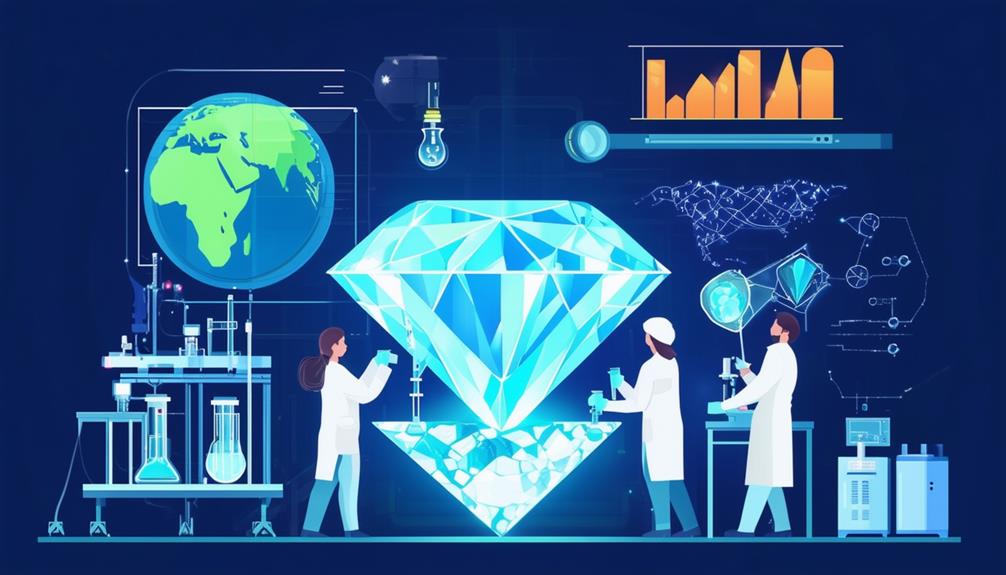Article Contents
Lab-grown diamonds, often promoted as an eco-friendly option, actually have a considerable environmental impact, with each polished carat resulting in approximately 511 kilograms of CO2 emissions. This figure is notably higher than the 160 kilograms of CO2 emitted per carat of traditionally mined diamonds.
However, the industry is making strides towards sustainability by increasingly utilising renewable energy sources like wind and solar power. Major companies such as Pandora are leading this shift by committing to 100% renewable electricity in their manufacturing processes.
This commitment not only helps meet environmental standards but also influences consumer choices towards more sustainable luxury products in the jewellery market, marking a significant step in the industry's evolution towards reducing its carbon footprint.
Key Points
- Each polished carat of lab-grown diamonds produces 511 kilograms of CO2.
- In comparison, mined diamonds generate 160 kilograms of CO2 per carat, making lab-grown diamonds significantly less carbon-efficient.
- Nevertheless, lab-grown diamonds are still promoted as an environmentally friendly option.
- The sector is actively seeking to incorporate renewable energy sources to decrease the carbon emissions associated with lab-grown diamonds.
- Implementing robust carbon offset measures is critical for lessening the environmental effects of these emissions.
Carbon Emission Comparison
Lab-grown diamonds emit 511 kilograms of CO2 per polished carat, significantly higher than the 160 kilograms emitted by mined diamonds. This difference raises concerns about the environmental benefits of synthetic diamonds, which are often marketed as a sustainable alternative. The high carbon emissions linked to the production of lab-grown diamonds highlight the need for effective carbon offsetting strategies within the industry.
While lab-grown diamonds are admired for their beauty and durability, the environmental impact associated with their production must not be ignored. With an increasing focus from consumers on environmental responsibility, the diamond industry is under pressure to improve transparency and innovation in reducing carbon emissions. Carbon offsetting could play a crucial role in this, allowing companies to offset their emissions through investments in environmental projects. However, it is essential to ensure the credibility of these offsetting initiatives, guaranteeing that they deliver genuine environmental benefits rather than being used as mere marketing tools.
For consumers who value both luxury and sustainability, understanding the complete environmental impact of these diamonds is crucial. A real commitment from the industry to reduce its carbon footprint is vital for preserving the appeal and perceived worth of lab-grown diamonds.
Renewable Energy Usage
The shift towards renewable energy in the production of lab-grown diamonds marks a significant advancement in the jewellery industry's commitment to sustainability.
By utilising green energy sources, these synthetic diamonds not only become more environmentally friendly but also contribute to the reduction of carbon emissions in luxury fashion.
This adoption underscores the industry's role in promoting ecological responsibility and sustainable luxury.
Energy Sources Explored
Pandora uses 100% renewable electricity, such as wind and solar energy, to create its lab-grown diamonds sustainably. This method greatly decreases the carbon footprint of their activities, in line with consumer preferences for environmentally friendly products.
By concentrating solely on renewable energy, Pandora guarantees that each item in their Brilliance collection not only meets aesthetic criteria but also follows ethical and environmental principles.
This dedication assists in lessening the ecological influence, establishing Pandora as a frontrunner in the sustainable luxury sector and enabling consumers to select products that mirror their principles.
Efficiency Improvements Impact
The integration of renewable energy sources into the production of lab-grown diamonds has significantly enhanced their energy efficiency. Previously, the creation of these gemstones required between 250 to 750 kilowatt hours per rough carat, leading to high energy consumption and a larger carbon footprint.
With this shift, companies like DeBeers have not only reduced energy usage but also lessened the environmental impact of their operations. This move demonstrates a commitment to sustainability and offers consumers a choice that supports both energy conservation and environmental responsibility, aligning with broader ecological values.
Impact on Ecosystems
Lab-grown diamonds, while not directly harming local wildlife and habitats, still indirectly pose challenges to ecosystems due to their high-energy production processes. These processes, which aim to replicate natural conditions for diamond formation, require substantial energy consumption and thus contribute to greenhouse gas emissions. Such energy demands can overload local resources and infrastructure, potentially disrupting the ecological balance.
The environmental impact of these production methods is not fully understood, as comprehensive data on their effects on ecosystems is lacking. This gap in knowledge makes it difficult to assess the true sustainability of lab-grown diamond manufacturing and its implications for biodiversity conservation. Nonetheless, the resilience of ecosystems is crucial, highlighting the need for the industry to adopt more environmentally friendly practices.
Encouraging responsible environmental practices in the production of lab-grown diamonds is essential for reducing their carbon footprint and enhancing overall sustainability. By focusing on energy efficiency and waste reduction, manufacturers can support ecological health and contribute to a more sustainable future in jewellery production. Adopting such practices is part of a broader commitment to conserving natural resources and maintaining a balanced relationship with the environment.
Certification and Standards
Certification standards such as SCS-007 and RJC are essential for ensuring the sustainability of lab-grown diamond production. These certifications verify that the diamonds are produced ethically and sustainably, fostering industry collaboration and encouraging responsible practices.
The benefits of these certifications include:
- Transparency: They create a clear framework for evaluating the environmental impact of production, ensuring that companies are responsible for their ecological footprint.
- Consumer Trust: Certifications provide consumers with confidence that the diamonds they buy meet recognised environmental standards.
- Market Differentiation: Certified producers can distinguish themselves, attracting consumers who prioritise sustainability.
Moving forward, it is crucial to establish consistent and comprehensive certification standards. This will enhance transparency in the industry, empower consumers to support and demand sustainably produced lab-grown diamonds, and drive overall sustainability in the industry. It will also offer choices to consumers who value ethical production methods.
Consumer Awareness Initiatives

In the jewellery industry, initiatives focused on consumer awareness are crucial for emphasising the sustainable aspects of lab-grown diamonds. These initiatives effectively communicate the significantly lower carbon emissions associated with these diamonds compared to mined ones and enhance transparency about their manufacturing methods.
This knowledge empowers consumers to make informed decisions and support brands committed to environmental responsibility.
Educational Campaigns Expand Knowledge
Educational campaigns about lab-grown diamonds are crucial for improving public knowledge of their reduced environmental impact. These efforts are key in:
- Increasing awareness of environmentally sustainable methods in diamond production.
- Highlighting the comparative environmental effects of traditional versus lab-grown diamonds.
- Emphasising the advantages of choosing diamonds that support environmental sustainability.
Such initiatives ensure that consumers are well-informed, promoting choices that are beneficial to the environment.
Transparency in Production Processes
For environmentally conscious consumers, understanding the production processes of lab-grown diamonds is crucial. The push for transparency in the supply chain and ethical sourcing requires manufacturers to disclose their methods, promoting environmental responsibility and ethical practices. However, the lack of standardised certification, such as SCS-007 or RJC, makes it challenging for consumers to evaluate the true sustainability of these diamonds.
| Aspect | Description | Impact on Consumer Choice |
|---|---|---|
| Certification | Inconsistent standards across the industry | Complicates assessment of sustainability |
| Communication | Essential for stakeholder engagement | Builds trust and deepens understanding |
| Transparency Efforts | Efforts to detail production processes | Facilitates well-informed purchasing |
| Production Practices | Examination of methods and their impacts | Encourages support for ethical producers |
This commitment to transparency is vital for consumers who value making informed choices that reflect their ethical and environmental values, ensuring alignment with their personal principles.
Industry Innovations
The jewellery industry, particularly through leaders like Pandora, is embracing technology to enhance sustainability. This shift is not merely about compliance but reflects a deep-seated commitment to sustainable practices, aligning with consumer expectations around environmental responsibility.
Pandora has implemented several innovative practices:
- Renewable Energy in Diamond Production: Pandora produces all its lab-created diamonds using renewable energy sources, supporting its objective to become carbon neutral by 2025.
- Use of Recycled Precious Metals: The Brilliance collection from Pandora features jewellery made entirely from recycled silver and gold, which cuts down emissions by 66% compared to new materials.
- Low Emission Products: The carbon emissions associated with Pandora's entry-level Brilliance items are on par with those of manufacturing a basic t-shirt, demonstrating a substantial reduction in environmental impact.
These initiatives reflect Pandora's commitment to reducing the jewellery industry's environmental footprint and highlight significant progress towards sustainable production practices.
Market Trends and Predictions

The increasing appeal of lab-grown diamonds is significantly influencing consumer preferences and transforming the jewellery industry's competitive dynamics. Market analysis suggests that these synthetic diamonds are on a trajectory to expand their market share by 7-8% annually. Predictions estimate that by 2035, lab-grown diamonds will constitute about 7.5-8.5% of the total diamond market, fuelled by growing consumer awareness regarding sustainability and ethical production practices.
This trend is compelling major jewellery retailers, including Pandora and De Beers, to incorporate lab-grown diamonds into their offerings, demonstrating a strategic response to evolving market conditions. The cost-effectiveness of lab-grown diamonds, which are typically 20-40% cheaper than their mined counterparts, further enhances their attractiveness to budget-conscious consumers, thereby facilitating deeper market penetration.
To sustain this growth, it is crucial for companies to optimise their supply chains and develop effective distribution strategies. These elements are essential for meeting consumer demand and ensuring the consistent availability of lab-grown diamonds. Therefore, the industry's competitive edge increasingly depends not only on the product appeal but also on the efficiency of operational processes to maintain growth and satisfy consumer needs in an evolving market.
Frequently Asked Questions
What is the carbon footprint of a lab-grown diamond?
The carbon footprint of a lab-grown diamond is estimated to be around 511 kg of CO2 per carat. This significant emission is primarily due to the high energy requirements of the production processes. Although there are advancements in the use of renewable energy sources, the overall efficiency of manufacturing methods heavily impacts the emissions.
Do Lab-Grown Diamonds Harm the Environment?
Lab-grown diamonds produce approximately 511 kg of CO2 per carat. Their creation consumes significant energy, often sourced from non-renewable resources, and requires a substantial amount of water, posing sustainability challenges.
Why are people opposed to lab-grown diamonds?
Opposition to lab-grown diamonds mainly comes from worries about their effect on the market and the genuineness of their environmental advantages. Critics suggest that these man-made diamonds could devalue natural diamonds and are doubtful about assertions of being more eco-friendly than mined diamonds.
What Are the Disadvantages of Lab-Grown Diamonds?
Lab-grown diamonds, which are frequently discussed in the jewellery industry, are being closely examined because of their large carbon footprint and reliance on finite energy sources. These issues question their claimed sustainability. Moreover, their reception in the market is hindered by consumer attitudes and their prices can fluctuate, making their situation in the market more complex.
Summary
In conclusion, the development of lab-grown diamonds represents a promising, more environmentally friendly alternative to traditional diamond mining. However, it also introduces new challenges.
The adoption of renewable energy and strict certification processes demonstrates a commitment to reducing environmental impact.
As consumer preference increasingly shifts towards these sustainable options, the importance of informed consumer choices and continuous innovation in the industry is critical.
This emerging sector is at a crucial juncture, blending historical practices with innovative approaches, and is set for significant evolution.

